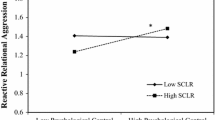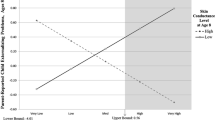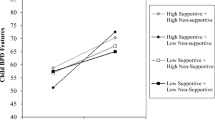Abstract
Skin conductance level reactivity (SCLR) was examined as a longitudinal mediator and moderator of relations between parental marital conflict and psychopathology among children and young adolescents. Participants were 157 boys and girls (M age at T1 = 9.31 years; SD = 1.97); there was a 2-year lag between T1 and T2 assessments. At T1, participants’ SCLR was assessed in response to lab challenges. Parents completed measures of aggressive marital conflict and child adjustment at T1 and T2. Supportive of moderation effects, T1 marital conflict interacted with T1 SCLR and gender in the prediction of changes in maladjustment. The link between marital conflict and increased internalizing and externalizing symptoms was stronger for girls with higher SCLR than girls with lower SCLR. Marital conflict predicted increased externalizing behaviors for boys with lower SCLR but not higher SCLR, although levels of externalizing behaviors were similar among boys with lower and higher SCLR especially at higher levels of marital conflict. Findings build on the literature by illustrating the importance of examinations of both family risk and youth biological vulnerability for the prediction of psychopathology.


Similar content being viewed by others
Notes
Children’s adjustment problems were examined through mothers’ reports at T1 and both mothers’ and fathers’ reports at T2. To ensure that the addition of fathers’ reports at Time 2 did not account for the change in adjustment problems over time, we conducted additional analyses using only mothers’ reports at T2. Results of these analyses (i.e., only mothers’ reports at Time 2) were nearly identical to results reported in the text using composites of mothers’ and fathers’ reports at T2. Specifically, using only mothers’ reports of outcomes at Time 2, marital conflict predicted greater internalizing problems at T2 for the sample, γ = 0.19, p < 0.001, and child gender moderated this effect, γ = 0.24, p < 0.01. Marital conflict was more strongly associated with internalizing problems for girls than boys. Marital conflict at T1 also predicted greater child externalizing problems at T2, γ = 0.24, p < 0.001, and this association was not moderated by child gender. The significance of these main effect and interaction results are identical to those using the mother–father composite score at Time 2.
When only mothers’ reports of outcomes were used at Time 2, results were identical to results reported in the text using composites of mothers’ and fathers’ reports at Time 2. That is, using only mothers’ reports of outcomes at Time 2, SCLR in response to the argument predicted neither internalizing nor externalizing problems. Controlling for SCLR in response to the argument did not alter relations between marital conflict and children’s adjustment problems.
Results were very similar when the outcomes at T2 were assessed with mothers’ reports alone. Three out of the four significant three-way interactions that emerged with mother–father composite scores at T2 were also significant using only mothers’ reports of outcomes at Time 2. The only exception was the interaction between gender, conflict, and SCLR in response to the star-tracing task in prediction of children’s internalizing problems. However, similar to findings based on the mother–father composite scores, follow-up analyses using mothers’ reports only revealed that the SCLR Star-Tracing by conflict interaction was significant for girls but not for boys, providing some support for this three-way interaction.
References
Agresti, A., & Finlay, B. (1997). Statistical methods for the social sciences (3rd ed.). Upper Saddle River, NJ: Prentice Hall.
Barlow, D. H. (2000). Unraveling the mysteries of anxiety and its disorders from the perspective of emotion theory. American Psychologist, 55, 1247–1263.
Baron, R. M., & Kenny, D. A. (1986). The moderator–mediator variable distinction in social psychological research: Conceptual, strategic, and statistical considerations. Journal of Personality and Social Psychology, 51, 1173–1182.
Beauchaine, T. (2001) Vagal tone, development, and Gray’s motivational theory: Toward an integrated model of autonomic nervous systems functioning in psychopathology. Development and Psychopathology, 13, 183–214.
Boucsin, W. (1992). Electrodermal activity. New York, NY: Plenum.
Cummings, E. M., & Davies, P. T. (2002). Effects of marital conflict on children: Recent advances and emerging themes in process oriented research. Journal of Child Psychology and Psychiatry and Allied Disciplines, 43(1), 31–63.
Cummings, E. M., Ballard, M., El-Sheikh, M., & Lake, M. (1991). Resolution and children’s responses to interadult anger as a function of gender, age, and mode of expression. Merrill-Palmer Quarterly, 37, 543–560.
Cummings, E. M., Goeke-Morey, M. C., & Papp, L. M. (2003). Children’s responses to everyday marital conflict tactics in the home. Child Development, 74, 1918–1929.
Cummings, E. M., Goeke-Morey, M. C., Papp, L. M., & Dukewich, T. L. (2002). Children’s responses to mothers’ and fathers’ emotionality and tactics in marital conflict in the home. Journal of Family Psychology, 16, 478–492.
Cummings, E. M., Pellegrini, D. S., Notarius, C. I., & Cummings, E. M. (1989). Children’s responses to angry adult behavior as a function of marital distress and history of interparent hostility. Child Development, 60, 1035–1043.
Davies, P. T., Harold, G. T., Goeke-Morey, M. C., & Cummings, E. M. (2002). Child emotional security and interparental conflict. Monographs of the Society for Research in Child Development, 67(3), 1–104.
Dishion, T. J., & Patterson, G. R. (2006). The development and ecology of antisocial behavior in children and adolescents. In D. Cicchetti, & D. J. Cohen (Eds.), Developmental psychopathology, volume 3: Risk, disorder, and adaptation (pp. 503–541). Hoboken, NJ: Wiley.
El-Sheikh, M. (1994). Children’s emotional and physiological responses to interadult angry behavior: The role of history of interparental hostility. Journal of Abnormal Child Psychology, 22, 661–678.
El-Sheikh, M. (2001). Parental drinking problems and children’s adjustment: Vagal regulation and emotional reactivity as pathways and moderators of risk. Journal of Abnormal Psychology, 110, 499–515.
El-Sheikh, M. (2005). The role of emotional responses and physiological reactivity in the marital conflict-child functioning link. Journal of Child Psychology and Psychiatry, 46, 1191–1199.
El-Sheikh, M. (2007). Children’s skin conductance level and reactivity: Are these measures stable over time? Developmental Psychobiology, 49, 180–186.
El-Sheikh, M., & Cummings, E. M. (1992). Availability of control and preschoolers’ responses to interadult anger. International Journal of Behavioral Development, 15, 207–226.
El-Sheikh, M., & Harger, J., (2001). Appraisals of marital conflict and children’s adjustment, health, and physiological reactivity. Developmental Psychology, 37, 875–885.
El-Sheikh, M., Harger, J., & Whitson, S. M. (2001). Exposure to interparental conflict and children’s adjustment and physical health: The moderating role of vagal tone. Child Development, 72, 1617–1636.
Fowles, D. C., Kochanska, G., & Murray, K. (2000). Electrodermal activity and temperament in preschool children. Psychophysiology, 37, 777–787.
Francis, D. J., Fletcher, J. M., Stuebing, K. K., Davidson, K. C., & Thompson, N. M. (1991). Analysis of change: Modeling individual growth. Journal of Consulting and Clinical Psychology, 59, 27–37.
Fung, M. T., Raine, A., Loeber, R., Lynam, D. R., Steinhauer, S. R., Venables, P. H., & Stouthamer-Loeber, M. (2005). Reduced electrodermal activity in psychopathy-prone adolescent. Journal of Abnormal Psychology, 114, 187–196.
Goeke-Morey, M. C., Cummings, E. M., Harold, G. T., & Shelton, K. H. (2003). Categories and continua of destructive and constructive marital conflict tactics from the perspective of U.S. and Welsh children. Journal of Family Psychology, 17(3), 327–338.
Harold, G. T., Shelton, K. H., Goeke-Morey, M. C., & Cummings, E. M. (2004). Marital conflict, child emotional security about family relationships and child adjustment. Social Development, 13, 350–376.
Herpertz, S. C., Mueller, B., Qunaibi, M., Lichterfeld, C., Konrad, K., & Herpertz-Dahlman, B. (2005). Response to emotional stimuli in boys with conduct disorder. American Journal of Psychiatry, 162, 1100–1107.
Hubbard, J. A., Smithmyer, C. M., Ramsden, S. R., Parker, E. H., Flanagan, K. D., Dearing, K. F., et al. (2002). Child Development, 73, 1101–1118.
Jaccard, J., Wan, C. K., & Turrisi, R. (1990). The detection and interpretation of interaction effects between continuous variables in multiple regression. Multivariate Behavioral Research, 25, 467–478.
Kagan, J., Reznick, J. S., & Snidman, N. (1987). The physiology and psychology of behavioral inhibition in children. Child Development, 58, 1459–1473.
Krantz, D. S., & Manuck, S. B. (1984). Acute psychophysiologic reactivity and risk of cardiovascular disease: A review and methodologic critique. Psychological Bulletin, 96(3), 435–464.
Luthar, S. S., Cicchetti, D., & Becker, B. (2000). The construct of resilience: A critical evaluation and guidelines for future work. Child Development, 71, 543–562.
McBurnett, K. (1992). Psychobiological approaches to personality and their applications to child psychopathology. In B. B. Lahey, & A. E. Kazdin (Eds.), Advances in clinical child psychology (vol. 14, pp. 107–164). New York: Plenum.
Nolen-Hoeksema, S., & Girgus, J. S. (2001). The emergence of gender differences in depression during adolescence. Psychological Bulletin, 115, 424–443.
Nolen-Hoeksema, S., Larson, J., & Grayson, C. (1999). Explaining the gender difference in depressive symptoms. Journal of Personality and Social Psychology, 77, 1061–1072.
Porges, S. W. (1991). Vagal tone: An autonomic mediator of affect. In J. Garber, & K. A. Dodge (Eds.), The development of emotion regulation and dysregulation: Cambridge studies in social and emotional development (pp. 111–128). New York: Cambridge University Press.
Porges, S. W. (1997). Emotion: An evolutionary by-product of the neural regulation of the autonomic nervous system. In C. S. Carter, I. I. Lederhendler, & B. Kirkpatrick (Eds.), The integrative neurobiology of affiliation. Annals of the New York Academy of Sciences, vol. 807 (pp. 62–77). New York, NY: New York Academy of Sciences.
Preacher, K. J., Curran, P. J., & Bauer, D. J. (2006). Computational tools for probing interaction effects in multiple linear regression, multilevel modeling, and latent curve analysis. Journal of Educational and Behavioral Statistics, 31(4), 437–448.
Raine, A. (2002). Biosocial studies of antisocial and violent behavior in children and adults: A review. Journal of Abnormal Child Psychology, 30, 311–326.
Raine, A., Venables, P. H., & Williams, M. (1990). Relationships between central and autonomic measures of arousal at age 15 years and criminality at age 24 years. Archives of General Psychiatry, 47, 1003–1007.
Raudenbush, S. W., & Bryk, A. S. (2002). Hierarchical linear models: Applications and data analysis methods (2nd ed.). Thousand Oaks, CA: Sage.
Rose, A. J., & Rudolph, K. D. (2006). A review of sex differences in peer relationship processes: Potential trade-offs for the emotional and behavioral development of boys and girls. Psychological Bulletin, 132, 98–131.
Scarpa, A., & Raine, A. (1997). Psychophysiology of anger and violent behavior. Psychiatric Clinics of North America, 20, 375–394.
Snoek, H., van Goozen, S. H. M., Matthys, W., Buitelaar, J. K., & van Engeland, H. (2004). Stress responsivity in children with externalizing behavior disorders. Development and Psychopathology, 16, 389–406.
Stanger, C., Achenbach, T. M., & Verhulst, F. C. (1997). Accelerated longitudinal comparisons of aggressive versus delinquent syndromes. Development and Psychopathology, 9, 43–58.
Straus, M. A. (1990). Measuring intrafamily conflict and violence: The conflict tactics (TS) scales. In M. A. Straus, & R. J. Gelles (Eds.), Physical violence in American families: Risk factors and adaptations to violence in 8,145 families. New Brunswick, NJ: Transaction.
Steinberg, L., & Avenevoli, S. (2000). The role of context in the development of psychopathology: A conceptual framework and some speculative propositions. Child Development, 71, 66–74.
Stern, R. M., & Sison, C. E. (1990). Response patterning. In J. T. Cacioppo, & L. G. Tassinary (Eds.), Principles of psychophysiology: Physical, social, and inferential elements (pp. 193–215). New York: Cambridge University Press.
Weems, C. F., Zakem, A. H., Costa, N. M., Cannon, M. F., & Watts, S. E. (2005). Physiological response and childhood anxiety: Association with symptoms of anxiety disorders and cognitive bias. Journal of Clinical Child and Adolescent Psychology, 34, 712–723.
Wirt, R. D., Lachar, D., Klinedinst, J. K., & Seat, P. D. (1990). Multidimensional description of child personality: A manual for the personality inventory of children (1990 ed.). Los Angeles: Western Psychological Services.
Author information
Authors and Affiliations
Corresponding author
Additional information
This research was supported by NIH Grant R29 AA10591.
Rights and permissions
About this article
Cite this article
El-Sheikh, M., Keller, P.S. & Erath, S.A. Marital Conflict and Risk for Child Maladjustment over Time: Skin Conductance Level Reactivity as a Vulnerability Factor. J Abnorm Child Psychol 35, 715–727 (2007). https://doi.org/10.1007/s10802-007-9127-2
Received:
Accepted:
Published:
Issue Date:
DOI: https://doi.org/10.1007/s10802-007-9127-2




